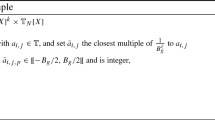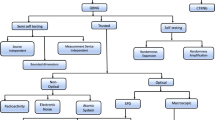Abstract
In this paper, we view filter generators as Boolean networks (BNs), and discuss their power-analysis-based side-channel analysis. An incompletely specified binary sequence always contains some bits called unnecessary bits comprising 1 or 0. Our motivation for considering this type of sequence is to reduce direct dependencies between side-channel information and key sequences. An algorithm is proposed to determine the unnecessary bits to increase the key search time required for adversaries rather than simply turning all unnecessary bits to 0 (or 1). Then, to reduce area dissipation, under the framework of semi-tensor product (STP) of matrices, the problem of constructing filter generators with minimum number of stages is converted into the one of determining the corresponding transition matrices. Compared with the existing results, the lower bound of the minimum number of stages is provided, which can reduce the exhaustive search time required to find it. Finally, one example is used to illustrate the efficacy of the proposed algorithm.
Similar content being viewed by others
References
Wang J, Mu J Q, Wei S Q, et al. Statistical characterization of decryption errors in block-ciphered systems. IEEE Trans Commun, 2015, 63: 4363–4376
Zhong J H, Lin D D. Driven stability of nonlinear feedback shift registers with inputs. IEEE Trans Commun, 2016, 64: 2274–2284
Zhong J H, Lin D D. Decomposition of nonlinear feedback shift registers based on Boolean networks. Sci China Inf Sci, 2019, 62: 039110
Zhao D W, Peng H P, Li L X, et al. Novel way to research nonlinear feedback shift register. Sci China Inf Sci, 2014, 57: 092114
Kauffman S A. Metabolic stability and epigenesis in randomly constructed genetic nets. J Theor Biol, 1969, 22: 437–467
Zhang Y, Liu Y. Nonlinear second-order multi-agent systems subject to antagonistic interactions without velocity constraints. Appl Math Comput, 2020, 364: 124667
Cheng D Z, Qi H S, Li Z Q. Analysis and Control of Boolean Networks: A Semi-tensor Product Approach. London: Springer, 2011
Zhong J, Liu Y, Kou K I, et al. On the ensemble controllability of Boolean control networks using STP method. Appl Math Comput, 2019, 358: 51–62
Lin L, Cao J D, Rutkowski L. Robust event-triggered control invariance of probabilistic Boolean control networks. IEEE Trans Neural Netw Learn Syst, 2020, 31: 1060–1065
Huang C, Lu J Q, Ho D W C, et al. Stabilization of probabilistic Boolean networks via pinning control strategy. Inf Sci, 2020, 510: 205–217
Zhu S Y, Lu J Q, Liu Y. Asymptotical stability of probabilistic Boolean networks with state delays. IEEE Trans Automat Contr, 2020, 65: 1779–1784
Zhong J, Li B W, Liu Y, et al. Output feedback stabilizer design of Boolean networks based on network structure. Front Inform Technol Electron Eng, 2020, 21: 247–259
Xu M X, Liu Y, Lou J G, et al. Set stabilization of probabilistic Boolean control networks: a sampled-data control approach. IEEE Trans Cybern, 2019. doi: https://doi.org/10.1109/TCYB.2019.2940654
Zhu S Y, Liu Y, Lou Y J, et al. Stabilization of logical control networks: an event-triggered control approach. Sci China Inf Sci, 2020, 63: 112203
Lu J Q, Sun L J, Liu Y, et al. Stabilization of Boolean control networks under aperiodic sampled-data control. SIAM J Control Opt, 2018, 56: 4385–4404
Liu Y, Li B W, Chen H W, et al. Function perturbations on singular Boolean networks. Automatica, 2017, 84: 36–42
Liu H C, Liu Y, Li Y Y, et al. Observability of Boolean networks via STP and graph methods. IET Control Theor Appl, 2018, 13: 1031–1037
Liu Y, Li B W, Lu J Q, et al. Pinning control for the disturbance decoupling problem of Boolean networks. IEEE Trans Automat Contr, 2017, 62: 6595–6601
Li Y Y, Liu R J, Lou J G, et al. Output tracking of Boolean control networks driven by constant reference signal. IEEE Access, 2019, 7: 112572
Wu Y H, Shen T L. A finite convergence criterion for the discounted optimal control of stochastic logical networks. IEEE Trans Automat Contr, 2018, 63: 262–268
Li Y L, Li H T, Xu X J, et al. Semi-tensor product approach to minimal-agent consensus control of networked evolutionary games. IET Control Theor Appl, 2018, 246: 2269–2275
Li H T, Wang Y Z. Boolean derivative calculation with application to fault detection of combinational circuits via the semi-tensor product method. Automatica, 2012, 48: 688–693
Lu J Q, Li M L, Huang T W, et al. The transformation between the Galois NLFSRs and the Fibonacci NLFSRs via semi-tensor product of matrices. Automatica, 2018, 96: 393–397
Dubrova E. On constructing secure and hardware-efficient invertible mappings. In: Proceedings of International Symposium on Multiple-Valued Logic, Sapporo, 2016. 211–216
Liu Z B, Wang Y Z, Cheng D Z. Nonsingularity of feedback shift registers. Automatica, 2015, 55: 247–253
Lu J Q, Li M L, Liu Y, et al. Nonsingularity of Grain-like cascade FSRs via semi-tensor product. Sci China Inf Sci, 2018, 61: 010204
Zhong J H, Lin D D. On minimum period of nonlinear feedback shift registers in Grain-like structure. IEEE Trans Inform Theor, 2018, 64: 6429–6442
Li N, Dubrova E. Synthesis of power- and area-efficient binary machines for incompletely specified sequences. In: Proceedings of Asia and South Pacific Design Automation Conference, Singapore, 2014. 634–639
Wan Z, Dai Z, Liu M, et al. Nonlinear Feedback Shift Registers (in Chinese). Beijing: Science Press, 1978
Zadeh A A, Heys H M. Simple power analysis applied to nonlinear feedback shift registers. IET Inform Secur, 2014, 3: 188–198
Dubrova E. Synthesis of binary machines. IEEE Trans Inform Theor, 2011, 57: 6890–6893
Dubrova E. Synthesis of parallel binary machines. In: Proceedings of the International Conference on Computer-Aided Design, San Jose, 2011. 200–206
Veliz-Cuba A. Reduction of Boolean network models. J Theor Biol, 2011, 289: 167–172
Burman S, Mukhopadhyay D, Veezhinathan K. LFSR based stream ciphers are vulnerable to power attacks. In: Proceedings of International Conference on Cryptology, 2007. 384–392
Goresky M, Klapper A. Algebraic Shift Register Sequences. Cambridge: Cambridge University Press, 2012
Li R, Yang M, Chu T G. State feedback stabilization for Boolean control networks. IEEE Trans Automat Contr, 2013, 58: 1853–1857
Acknowledgements
This work was supported by National Natural Science Foundation of China (Grant No. 61973078), Natural Science Foundation of Jiangsu Province (Grant No. BK20170019), Jiangsu Provincial Key Laboratory of Networked Collective Intelligence (Grant No. BM2017002), Jiangsu Province Six Talent Peaks Project (Grant No. 2015-ZNDW-002), Fundamental Research Funds for the Central Universities (Grant No. 2242019k1G013), and Postgraduate Research & Practice Innovation Program of Jiangsu Province (Grant No. KYCX19_0111).
Author information
Authors and Affiliations
Corresponding author
Rights and permissions
About this article
Cite this article
Li, B., Lu, J. Boolean-network-based approach for construction of filter generators. Sci. China Inf. Sci. 63, 212206 (2020). https://doi.org/10.1007/s11432-019-2813-7
Received:
Revised:
Accepted:
Published:
DOI: https://doi.org/10.1007/s11432-019-2813-7




